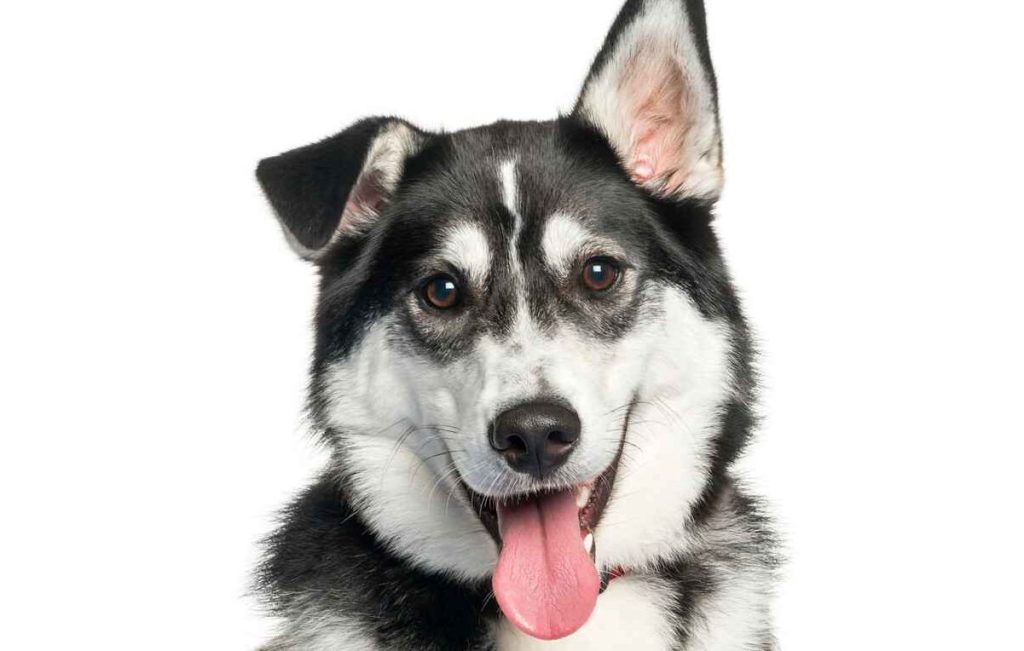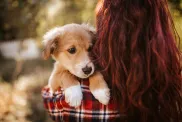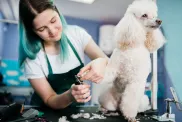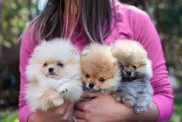The Labsky, also known as the Siberian Retriever or Huskador, is a medium to large-sized cross between the Labrador Retriever and Siberian Husky dog breeds. Active, smart, and loyal, these pups inherited some of the best qualities from both of their parents. Despite their high-end image, you may find these mixed-breed dogs in shelters and rescues.
These adorable canines make for super loyal and devoted family pets, and they’re usually very easy to train and quick to learn new commands. But a heads up: Labskies are dogs who like to remain active, so be prepared for lots of extra long walks. Often seen as smarter than the average dog, Labskies also benefit from interactive dog toys.
Labsky characteristics
- Height: 20 to 28 inches at the shoulder
- Weight: 40 to 60 pounds
- Lifespan: 10 to 12 years
Coat color and variations
The Labsky can inherit a wide range of coat colors and patterns due to the diverse genetics of both parent breeds. Labskies typically have a double coat like both parents, which may be short to medium in length, with a dense undercoat. Their coats can vary in thickness and texture, but they are usually well-suited to different weather conditions.
Labskies also come in a diverse array of coat colors and patterns. Their coats can range from solid colors like black, chocolate, yellow, or cream — often inherited from the Labrador side —to more complex patterns typically seen in Huskies. These include gray or silver shades, black and white combinations, and the striking sable coloration. Some Labskies may display rarer coat types such as the wolf-like agouti pattern or the tiger-striped brindle. Bi-color and tri-color coats are also possible, featuring combinations of black, brown, white, and gray. The specific coat color and pattern of a Labsky can vary greatly, reflecting the rich genetic diversity of this mixed breed.
Physical traits and appearance
- Size and Build: The Labrador Siberian Husky mix is medium to large-sized. They are usually well-muscled and athletic and may have the broader chest of a Labrador or the leaner build of a Husky.
- Head and Face: Often have a broader skull like a Labrador, but may have the more angular features of a Husky. Their ears can be floppy like a Lab’s or erect like a Husky’s with eyes in brown, blue, or heterochromatic (two different colors).
- Coat: The Labsky is double-coated, with a dense undercoat and a longer outer coat. The coat length can vary from medium to long with diverse coat colors and patterns.
- Tail: The Labsky’s tail is usually long and thick, but may be curved over the back like a Husky’s or straight like a Lab’s.
How big does a Labsky get?
Typically, the Labsky weighs between 40 and 60 pounds, although some may be larger depending on the parent. They usually stand between 20 and 25 inches tall at the shoulder.

Labsky history
Labskies or Huskadors emerged as part of the designer dog trend that gained popularity in the late 20th and early 21st centuries. This trend involved intentionally crossing purebred dogs to create new mixed breeds with desirable traits from both parent breeds.
The exact origin of the Labsky is not precisely documented, but they likely first appeared in the 1990s or early 2000s. The breed was created by crossing Labrador Retrievers with Siberian Huskies, aiming to combine the friendly, outgoing nature of the Lab with the striking appearance and endurance of the Husky.
The Labsky is not recognized as a standardized breed by major kennel clubs like the American Kennel Club (AKC) or the United Kennel Club (UKC). However, they are recognized by some designer breed registries and have gained popularity among dog enthusiasts looking for a unique companion with traits from both parent breeds.
Labsky personality
Labskies inherit personality traits from both Labrador Retrievers and Siberian Huskies, resulting in a unique and often energetic temperament. They are typically friendly, outgoing, and intelligent dogs with a strong desire for human companionship. Labskies often display the Lab’s eagerness to please and the Husky’s independent streak, which can make them both affectionate and sometimes stubborn.
Due to their Husky heritage, Labskies may have a strong prey drive and a tendency to wander or escape if not securely contained. They are often vocal, expressing themselves through a range of sounds from barks to the Husky’s characteristic “talking” or howling.
Temperament and behavior
- Highly energetic and playful: Labskies inherit high energy levels from both parent breeds. They require significant daily exercise, typically 1-2 hours of active play or exercise per day. This could include long walks, runs, fetch games, or swimming. Without adequate exercise, they may become destructive or develop behavior problems.
- Intelligent and trainable: These dogs are typically quick learners, inheriting the intelligence of both Labs and Huskies. They excel in obedience training and often enjoy learning new tricks or commands. However, their intelligence also means they can get bored easily, so varied and engaging training sessions are crucial.
- Strong desire for human companionship: Labskies are usually very social dogs that form strong bonds with their families. They thrive on attention and interaction and may suffer from separation anxiety if left alone for long periods. This trait makes them excellent family dogs but also means they require consistent attention and companionship.
- Can be stubborn or independent at times: While generally eager to please like Labs, Labskies can inherit the Husky’s independent streak. This may manifest as occasional stubbornness during training or a tendency to make their own decisions. Consistent, positive reinforcement-based training from an early age is key to managing this trait.
- Potential to wander or escape: Huskies are known for their escape artist tendencies, and Labskies may inherit this trait. They may dig under or jump over fences if left unsupervised outdoors. Secure fencing and careful monitoring during outdoor time are important to keep a Labsky safe.
Training and socialization
Early socialization and positive reinforcement training are crucial due to their intelligence and potential stubbornness. Of course, their intelligence allows them to pick up commands quickly, so early training is key to establishing good behavior from the start. Use praise, treats, and affection to reward desired behavior. Cavachons are sensitive and respond well to positive reinforcement.
Training tips:
- Be Consistent: Consistency is crucial in training. Use the same commands and routines to avoid confusion. This helps your Labsky understand what is expected of them.
- Keep Training Sessions Short and Fun: Labskies are intelligent but can lose interest if training sessions are too long or repetitive. Keep sessions short (10-15 minutes) and engaging with varied activities.
- Mental Stimulation: Incorporate puzzle toys, obedience training, and interactive games into their routine to challenge their mind. A bored Labsky can become restless or destructive. Once basic obedience is established, teach more advanced commands or tricks. Their intelligence makes them excellent candidates for agility training, fetch, or scent games.
How long can the Labsky be left alone?
Labskies, like most dogs, should not be left alone for extended periods. However, the specific duration can vary depending on the individual dog’s temperament, training, and age.
Adult Labskies (over 18 months old):
- Ideally: 4-6 hours maximum
- In necessary situations: Up to 8 hours, but not regularly
Puppies and young Labskies (under 18 months):
- Much shorter periods, typically no more than 2-4 hours
Remember, even if a Labsky can physically handle being alone for 8 hours, it’s not ideal for their mental and emotional well-being to do this regularly. If long absences are unavoidable, it’s crucial to ensure they receive plenty of attention, exercise, and stimulation when you are home.
Labsky care
As with all dogs, it’s important to keep up your Labsky’s regular veterinary checkups to detect any health concerns early. Your vet can help you develop a care routine that will keep your dog healthy.
Labsky grooming needs
Proper grooming not only keeps a Labsky looking good but also contributes to their overall health and can strengthen the bond between dog and owner. The exact grooming needs may vary depending on the individual dog’s coat type and lifestyle. However, it’s worth noting that Labskies have moderate to high grooming needs due to their double coat inherited from both parent breeds. They are prone to periods of high shedding.
Coat care:
- Brushing: 2-3 times per week normally, daily during shedding seasons
- Shedding: Moderate year-round, heavy twice a year (spring and fall)
- Bathing: Every 6-8 weeks or as needed, avoid over-bathing
Nail care:
- Trim nails every 3-4 weeks or as needed
- Regular walks on hard surfaces can help naturally file nails
Dental care:
- Brush teeth 2-3 times a week, daily if possible
- Provide dental chews or toys to help maintain oral health
Eye and ear care:
- Check and clean ears weekly, especially if they’re floppy like a Lab’s
- Watch for signs of infection like redness, odor, or excessive wax
- Wipe around the eyes regularly to prevent tear stains
- Check for any signs of irritation or infection
Additional considerations:
- Professional grooming every 2-3 months can be beneficial
- Pay extra attention to coat care during shedding seasons
- Regular grooming sessions are a good opportunity to check for any skin issues or abnormalities.
Early acclimation is key
Getting your Labsky accustomed to grooming procedures from a young age makes the process easier and more enjoyable for both of you. Handle their paws frequently, examine their mouth and ears, and reward them for good behavior during grooming sessions. This positive foundation sets the stage for stress-free veterinary exams and handling throughout their lives.
Feeding and nutrition
As with all dogs, the Labsky’s dietary needs will change from puppyhood to adulthood and will continue to change into their senior years. You should ask your veterinarian for recommendations about your Labsky diet, as there is far too much variation among individual dogs to make a specific recommendation.
General guidelines:
- Puppy: Follow the feeding guidelines on the dog food packaging.
- Adult: A good starting point is 1-2 cups of high-quality dog food per day, divided into 2-3 meals.
- Senior: As dogs age, their activity levels may decrease and their metabolisms may slow down. Reduce portion sizes accordingly.
Feeding frequency:
- Puppies: Frequent meals (3-4 times a day) are necessary for growth and development.
- Adults: 2-3 meals a day are generally sufficient.
- Seniors: Adjust meal frequency and portion sizes based on your dog’s activity level and overall health.
High-quality dog food:
- Avoid foods with excessive fillers, artificial additives, or by-products.
- Choose a premium, well-balanced dog food formulated for small to medium breeds. Look for food with high-quality animal proteins (such as chicken, turkey, or fish) listed as the primary ingredient.
Labsky and family compatability
Labskys, a hybrid of Labrador Retriever and Siberian Husky, are generally considered excellent family dogs. They inherit many desirable traits from both parent breeds, making them suitable for a variety of households.
Positive traits for families:
- Energetic and playful: Labskys love to be active and enjoy spending time outdoors. They are great companions for families who enjoy hiking, running, or playing fetch.
- Loving and affectionate: Both Labrador Retrievers and Siberian Huskies are known for their friendly and affectionate nature. Labskys typically inherit these qualities, making them great with children and adults.
- Intelligent: Labskys are intelligent dogs and are quick learners. They can be trained with positive reinforcement and enjoy mental stimulation.
- Good with children: With proper socialization, Labskys can be great with children. They are typically gentle and patient, but supervision is always recommended, especially with young children.
- Adaptable: Labskys are adaptable dogs and can thrive in various living situations, including apartments and houses with yards.
Considerations:
- Socialization: Early socialization is crucial for Labskys to develop good behavior and get along with other animals and people.
- High energy: Labskys require regular exercise and mental stimulation. They may not be the best choice for families who are not able to provide sufficient physical activity.
- Shedding: Both Labrador Retrievers and Siberian Huskies are heavy shedders. Labskys inherit this trait, so they may not be the best choice for people with allergies or a preference for low-shedding dogs.
- Training: While Labskys are intelligent, they can be stubborn at times. Consistent training with positive reinforcement is essential.
Labsky health issues
Labskys are generally healthy dogs, but they can be prone to certain health conditions. Here are some common issues to be aware of:
- Cataracts: A clouding of the lens of the eye, which can lead to blurred vision or blindness.
- Glaucoma: Increased pressure within the eye, which can damage the optic nerve and lead to blindness.
- Allergies: Allergies are a hypersensitivity to allergens, resulting in a condition where the immune system overreacts to harmless substances, causing symptoms like sneezing, itching, and runny nose.
- Hip Dysplasia: A condition where the ball and socket of the hip joint do not fit together properly, leading to pain, lameness, and arthritis.
Preventing health problems
To help your Labsky live a long and healthy life, it’s essential to prioritize preventative care. Regular veterinary checkups are crucial for early detection and treatment of potential health issues. Providing a high-quality diet and ensuring adequate exercise helps maintain a healthy weight and reduces the risk of obesity-related problems. Preventative measures like vaccinations, heartworm prevention, and dental cleanings can protect your Labsky from common diseases and infections. If you’re considering breeding your Labsky, genetic testing can help identify carriers of inherited health conditions. By taking these proactive steps, you can significantly improve your Labsky’s chances of enjoying a happy and healthy life.
Labsky rescue groups
It may be difficult to find a non-profit rescue group that exclusively handles Labsky dogs. However, there are several Siberian Husky and Labrador breed-specific rescues that sometimes help mixes of those breeds find homes. Search for a rescue near you or find an online rescue database that lets you search for adoptable dogs by breed and zip code. Here are some breed-specific rescues that may be able to help find the right Labsky for you:













